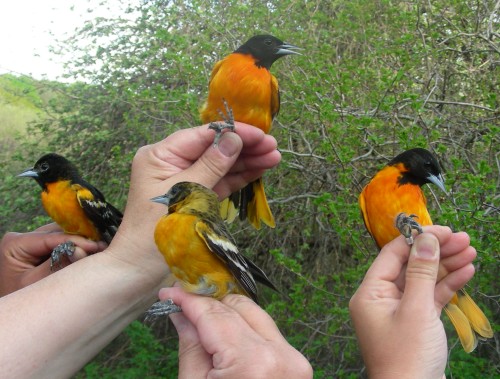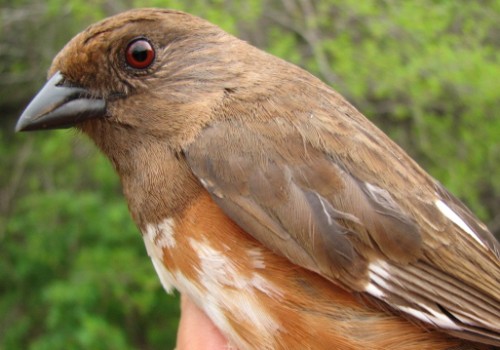|
McGILL BIRD OBSERVATORY |
|||||||||||||||||||||||||||||||||||||||||||||||||||||||||||||||||||||
Welcome
to the McGill Bird Observatory weekly report.
Click here for a complete listing of our archives.
Banders-in-charge: Barbara
Frei, Marie-Anne Hudson Notes: The migration floodgates opened this week with 13 news species observed and a whopping 19 new species banded! New species include many warblers, flycatchers and vireos, all streaming northward to breed. The 91 species observed this week is by far the highest one-week total so far this spring, and beats last year's count of 85 during the same week. Also, it is the first time ever at MBO that we've banded 200 birds in a week during the spring season! Not only are there birds everywhere to the point of being overwhelming for our dedicated censusers, but those sticking around are getting ready to breed! We’ve been keeping our eyes peeled for any sign of nesting since both BICs are rather obsessed with the notion (as we are both studying breeding birds in our “other lives” as graduate students). We’ve noticed a few hard-working soon-to-be parents shuttling nesting material back and forth (Red-winged Blackbirds, Song Sparrows and Tree Swallows), and some keeners have even laid and are currently incubating (Song Sparrow, Blue Jay)! We’re following all nests with keen interest as banding the nestlings allows us to accumulate data on known-aged birds. With any luck they’ll return to us next year to build their own nests. Though all sightings are special in their own right, some are “more special” than others. Case in point: MBO’s second ever Northern Mockingbird was spotted on Saturday, along with another Sandhill Crane. Friday’s visit by the Bishop University’s Ecology class, led by our very own Shawn Craik, finally netted us our first Eastern Towhee. Add in a second-year Golden Eagle flying lazily eastward on Thursday and you’ve got some very excited banders. With this week of many firsts (for MBO, for the year, and for spring), we can’t imagine what’s just around the corner, especially considering that last year it was in week 8 that we hit our peak of diversity for the season.
Our top ten species observed is somewhat different from last week’s, as the Canada Geese have pretty much disappeared save for our rather persistent pair in the back pond, right at the same time as in 2006. The abundant, early-week arrival of Yellow Warblers has allowed them to vault to sixth position overall, and the ongoing Red-winged Blackbird migration, along with resident breeders, has enabled them to take over the top spot. Red-winged Blackbirds dominated the top ten banded list, with several small flocks inundating the B/N nets over a few days mid-week. The flocks consisted mostly of females, which arrive here considerably later than the males. This week’s top ten also shows that the warblers have landed, with 4 of the spots taken up by them. Although 3 warblers had made their way into the list at this time last year (the same species as this year, except with Magnolia missing), numbers were far lower still at this point, with Yellow-rumped the most common among them and only 5 of those banded. Conspicuously absent from this week's banding list is Common Grackle, which ranked all the way up in second place at this time last year. We hope that the warblers - and all the others - continue to sing and hop about until at least Saturday so that we can count them on our Birdathon. Please wish us much luck and many species as we attempt to raise funds for MBO, and have a great time to boot. If you haven't already done so, please visit our Birdathon page for information on how to join us or support our efforts - a successful effort will be critical to ensuring that we can operate the spring migration monitoring program again in 2007! With the sort of results we've seen this week, we'd hate to have to pass it up because of funding shortages.
|



